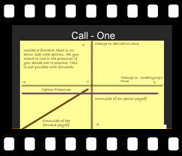| The “Option Pricing using Binomial Trees” video course presents an alternative method of implementing a two-dimensional binomial tree compared to the traditional method of building a binomial tree in Excel. The alternate approach is based on the techniques documented by Professor Mark Broadie at Columbia Business School as part of his coursework in Security Pricing and Computational Finance courses at Columbia University. |
 |
The benefit of this methodology over the conventional approach is that it allows for the extension of a simple 3 step tree to a 50 – 100 step option pricing tree in a few minutes. This is not only a more efficient approach to binomial trees but the increased number of time-steps ensures greater accuracy in most cases of option pricing. The course begins with the pricing of plain vanilla European calls and put options; then is followed with the pricing of American options and finally with the pricing of Knock out and Knock in (Sudden Death) exotic options.
Course Prerequisites
Familiarity with derivative products and comfortable with basic mathematics, numbers and EXCEL.
Course Audience
The course is targeted at intermediate and advance users and is aimed at professionals who deal with pricing, valuation and risk issues related to structured fixed income and foreign exchange transactions.
Course Guide
Here is the structure of the course.
|
|
|
|
| Session 1 – Theoretical Overview of Derivatives and their Payoffs |
32:20 mins |
|
| Session 2 – Option Pricing using the Conventional Binomial Tree Approach |
28:14 mins |
|
| Session 3 – Option Pricing using the Efficient Tree Approach |
16:04 mins |
|
| Session 4 – Pricing American Options & Exotics using the Efficient Binomial Tree Approach |
14:56 mins |
|
| Session 5 – Increasing time steps and improving result accuracy using the Efficient Binomial Trees Approach |
10:16 mins |
|
Session One – Theoretical Overview of Derivatives and their Payoffs
|
| In this part we present a theoretical overview of derivatives. We make use of a graphical tool to explain payoff profiles of the different types of derivatives, starting with a forward contract and moving on to call and put options. We discuss the similarity between the payoff profile of a long position in a forward contract and that of owning the underlying and the difference that a limited downside makes on the payoff profile of a call option. Next we have a discussion of important derivatives terminology and indicate the inputs needed for determining an option value. We show how the same inputs used in the Black Scholes equation can be used in numerical techniques for solving option value such as binomial trees. We present a basic overview of the mechanics of building binomial trees and explain how the values for risk-adjusted probabilities and up and down movements are calculated.
|
|

View a sample of session one
|
Session Two: Option Pricing using the Conventional Binomial Tree Approach
|
| In this part we see how the binomial trees are constructed in EXCEL for a European call option using the conventional approach or as we like to call it the wrong approach. A one step binomial tree is built using an intuitive approach as well as the conventional approach. Then a two step conventional binomial tree is constructed. This improves the estimate but increases the complexity of tree construction. We discuss how in order to further improve accuracy the number of steps needs to be increased but this means more unwieldiness if using the traditional approach. For this reason we term it as the wrong approach and instead suggest the use of Mark Broadie’s more efficient approach to binomial tree construction.
|
|

View a sample of session two
|
Session Three: Option Pricing using the Efficient Tree Approach
|
| In this part we see how binomial trees may be constructed in EXCEL using a much more efficient “correct” approach as proposed by Mark Broadie and Paul Glasserman in their derivatives course at Columbia University. The approach makes it much easier to extend the tree for increased time steps as compared to the traditional approach. We illustrate the construction of the tree for a European call option and then show how easily and quickly it can be updated for a European put option.
|
|

View a sample of session three
|
Session Four: Pricing American Options & Exotics using the Efficient Binomial Tree Approach
|
| In this part we show how the basic European call option worksheet under the efficient binomial tree method may be updated for American call and put options as well as for exotic options. The process can be easily and quickly accomplished under the given method. We discuss and compare the values option for the European call and American call options as well as for the European put and American put options and the reasons for their similarity/ difference.
We then extend the discussion to the construction of the binomial tree for exotics, such as barrier options, in particular the knock out or up-and-out call option.
|
|

View a sample of session four
|
Session Five: Increasing time steps and improving result accuracy using the Efficient Binomial Trees Approach
|
| In the final part we check the accuracy of the estimated value of a European call option using the Efficient Binomial tree method against the actual value of the option calculated using the Black Scholes solution. We illustrate the ease with which the model can be extended for increased time steps and show the impact of this modification on the accuracy of the results. We discuss how the option price sensitivities may be assessed by changing input parameters, such as volatility, and looking at the impact of such changes on the results of the tree.
|
|

View a sample of session five
|
| |
| Back to top |




